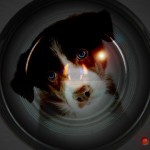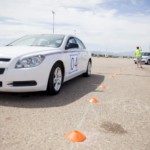 Scientists at the Department of Energy’s SLAC laboratory have taken a “molecular movie” of a chemical reaction for the first time. The results of their research could give new insights into to how chemical bonds form, helping researchers better understand biological processes. To give you an idea of the difficulty of the feat, the critical part of the reaction — the breaking apart of a ring-shaped gas molecule — takes a mere 200 femtoseconds (quadrillionths of a second). To record such a rapid process, the researchers used the two mile long Linac Coherent Light Source (LCLS) to fire X-ray laser pulses a mere 25 quadrillionths of a second in duration. The molecular changes are not captured with visible light like a camera takes a picture, however. Here’s how it works: first, the chemical reaction is initiated by blasting the gas (1, 3-cyclohexadiene) with a separate, high-powered optical laser. That breaks the molecular bonds, converting it into another gas called hexatriene. While the chemical transformation is still in action, the LCLS X-ray laser strikes the altered molecule, creating a distinctive diffraction pattern that’s capture by a detector. The shape of the pattern on the detector helps scientists “infer back what’s going on the molecule, ” according to lead scientist Mike Minitti. By varying the time between the optical laser that kicks off the reaction and the X-ray laser (in 25 femtosecond increments), the team could see the chemical bonds breaking apart step-by-step. It took about 100, 000 measurements to get enough data to create a simulated “molecular movie” showing the complete transformation. It happens so fast that if it were possible to film it using a real camera, it would have to roll at around 30 trillion frames per second. “Before your eyes, a chemical reaction is occurring that has never been seen before this way, ” said Minitti. As a result, the study helped resolve “long standing questions about how this (ring-shaped) molecule actually opens up, ” he added. With the first successful observation of a rapid chemical transformation in a simple gas, the SLAC scientists plan to move onto larger molecules. Filed under: Science , Alt Comments Source: Stanford University
Scientists at the Department of Energy’s SLAC laboratory have taken a “molecular movie” of a chemical reaction for the first time. The results of their research could give new insights into to how chemical bonds form, helping researchers better understand biological processes. To give you an idea of the difficulty of the feat, the critical part of the reaction — the breaking apart of a ring-shaped gas molecule — takes a mere 200 femtoseconds (quadrillionths of a second). To record such a rapid process, the researchers used the two mile long Linac Coherent Light Source (LCLS) to fire X-ray laser pulses a mere 25 quadrillionths of a second in duration. The molecular changes are not captured with visible light like a camera takes a picture, however. Here’s how it works: first, the chemical reaction is initiated by blasting the gas (1, 3-cyclohexadiene) with a separate, high-powered optical laser. That breaks the molecular bonds, converting it into another gas called hexatriene. While the chemical transformation is still in action, the LCLS X-ray laser strikes the altered molecule, creating a distinctive diffraction pattern that’s capture by a detector. The shape of the pattern on the detector helps scientists “infer back what’s going on the molecule, ” according to lead scientist Mike Minitti. By varying the time between the optical laser that kicks off the reaction and the X-ray laser (in 25 femtosecond increments), the team could see the chemical bonds breaking apart step-by-step. It took about 100, 000 measurements to get enough data to create a simulated “molecular movie” showing the complete transformation. It happens so fast that if it were possible to film it using a real camera, it would have to roll at around 30 trillion frames per second. “Before your eyes, a chemical reaction is occurring that has never been seen before this way, ” said Minitti. As a result, the study helped resolve “long standing questions about how this (ring-shaped) molecule actually opens up, ” he added. With the first successful observation of a rapid chemical transformation in a simple gas, the SLAC scientists plan to move onto larger molecules. Filed under: Science , Alt Comments Source: Stanford University
Originally posted here:
Crazy fast X-ray laser catches chemical reactions in the act







